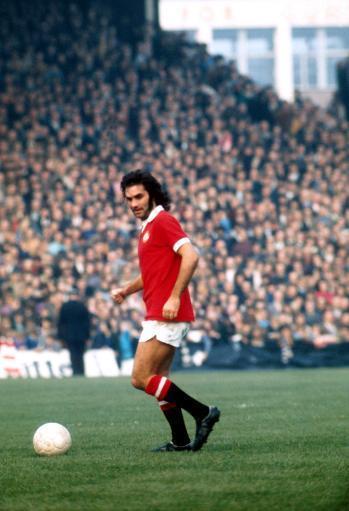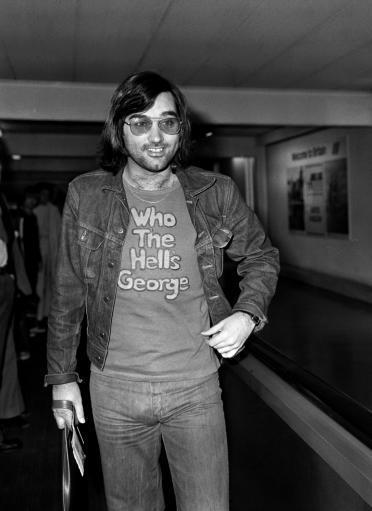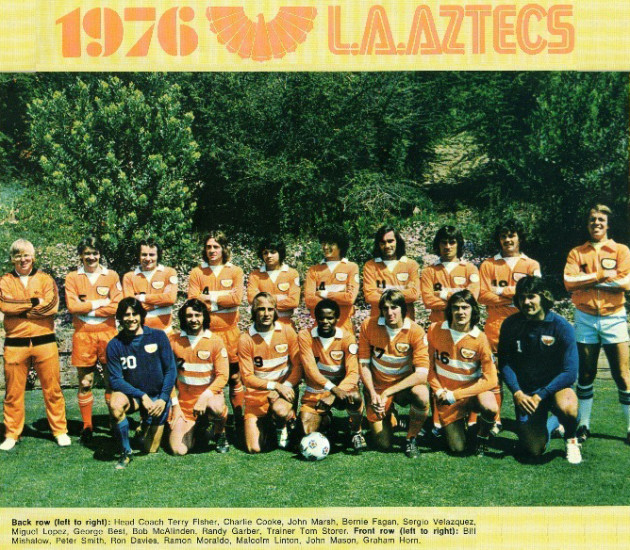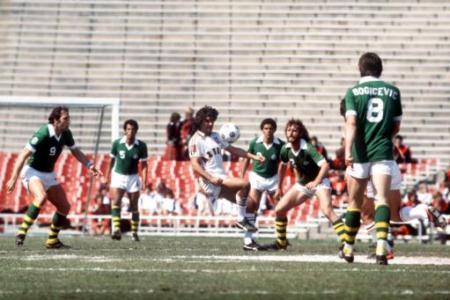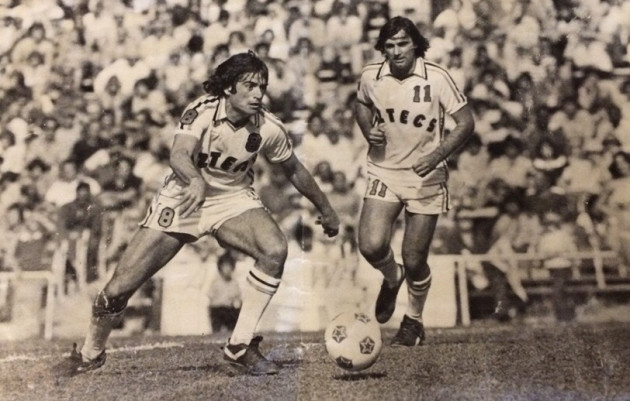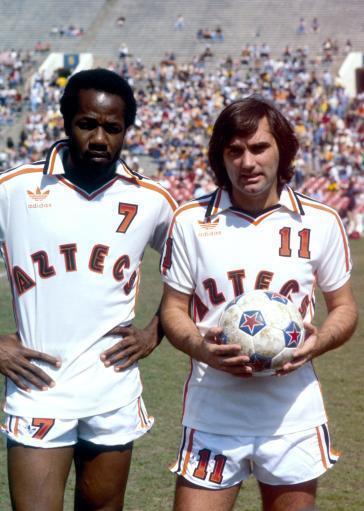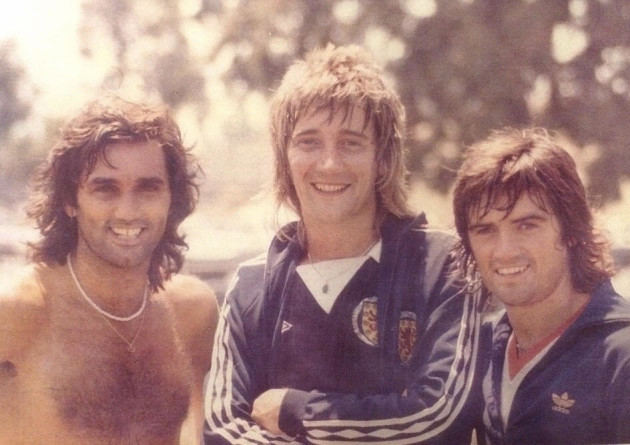IT HAD BEEN two years since the end.
Manchester United versus Plymouth, the FA Cup game that George Best infamously didn’t feature in. He had skipped Thursday’s training session but turned up early on Friday morning to make amends. It seemed to diffuse the situation and then-United boss Tommy Docherty subsequently named him in the match-day squad later that afternoon. But when the teams were submitted on the Saturday, Best’s name was missing. He’d been dropped in favour of Mick Martin. The following week, Best ditched training again and he was left out of the United group for the upcoming trip to West Ham.
The next day, he was made available for transfer. At 27, he would never play top-flight English football again.
And so began a bizarre series of humiliating but lucrative escapades as Best flogged his wears to the highest bidder. There were a handful of games for Jewish Guild in Johannesburg, where he was greeted at the airport by a chorus of girls from the local Follies stage show. That lasted for five games before a return to the UK and a couple of run-outs with non-league side Dunstable Town (as a favour to his old United buddy Barry Fry) and with Stockport County in Division Four. Further ignominy lay ahead and a heavily-bearded, overweight and unfit Best endured a miserable stint in the League of Ireland with Cork Celtic. After three languid displays, Celtic manager Paul O’Donovan offered a withering assessment of the much-vaunted acquisition.
“I cannot believe that a player of his calibre can go off so much,” was the damning review of his own player.
It was early 1976 and Best found himself at a particularly low ebb: bouncing between countries, scrounging for scraps. But there was a lifeline: America.
“I’d stayed in touch with George and I’d see him on occasion around town,” says Bobby McAlinden.
“We were friends – not the greatest of friends – but friends nonetheless. There was a bunch of us that used to go to the YMCA and another place in Stalybridge and we’d play a lot of 5-a-sides during the week. After he left United, George used to show up and play with us alongside some other guys he knew from the club scene in Manchester. It was great and I even think Rodney Marsh played with us once or twice.”
“One night, this would have been late in ’75, George said, ‘Listen, I’m going to make a comeback. I want to start playing again in America. Everyone thinks I’m going to New York but I’m not. I don’t want to go there. I’m going to LA, to California. They’ve asked me to recommend a player or two. Do you want to go?’ I said, ‘Do I want to go? I’m fucking sure I want to go.” I was back living at home with my Mam and Dad. It was around November time and he said, ‘I’m going in February, I’ll get in touch with you. Stay fit’. And he called me early the following year and off we went.”
By that stage, the pair had known each other for over a decade. When Best was a teenager and playing at youth level for Manchester United, McAlinden was doing likewise across town at Maine Road. Their paths crossed repeatedly, on and off the pitch.
“It was very obvious – there was a buzz about him right away when he was fifteen,” says McAlinden.
“It wasn’t difficult to see. And all of that promise came to fruition. By seventeen, he had got in the first team and obviously he was gonna stay there. He shot up a little bit and had a growth spurt. He got bigger – not brawny but stronger – and was very, very quick. We were playing them in the FA Youth Cup in 1964 and we had a very good side – Glyn Pardoe, Mike Doyle. United never played him in the early rounds because he was in the first team at that point and they wanted to protect him. But we played a two-legged semi-final against them: one game at Old Trafford, the other at Maine Road. United played him in that and he ran fucking rings around us. They beat us 4-1 and 4-3. They were just too good and only because George played. If he wasn’t involved, we’d have won it. And they ended up winning the cup.”
“The kids from United and City tended to socialise in the same places. We’d go to the Stretford Bowling Alley and places like that. So we knew each other and were around each other quite a bit. And then we found out this huge coincidence: me and George were born on the exact same day – May 22nd 1946.”
There was always a deep connection, even when George became ‘Georgie’ and McAlinden began to slip between the cracks. By the time Best became ‘El Beatle’ in 1966, his pal found himself in – of all places – east Belfast. He spent a season with Glentoran, the club Best supported as a child and whose games he attended alongside his grandfather. And it proved a successful stint too as McAlinden picked up an Irish Cup winner’s medal. But he admits he was impatient and that he should have stayed at The Oval beyond a solitary campaign. The cup victory meant European football and the chance to put himself in the shop window. Instead, having already spent some time playing in Toronto with Stanley Matthews in 1964, McAlinden was enticed by opportunities further afield.
So, he watched from afar as the club subsequently racked up high-profile ties against Rangers (Cup Winners’ Cup in ’66) and Benfica (European Cup in ’67) in the coming seasons.
“I made a lot of bad decisions,” he says.
“Instead of staying at Glentoran, I went off to play in South Africa. I’d wanted more money and was interested in broadening my horizons. But Glentoran ended up playing in some big European games. Against Benfica, they drew 1-1 in Belfast and 0-0 in Lisbon and they only went out on away goals. That was a big, big result. That Benfica team went on to reach the final and played against George and United at Wembley. So, a lot of the players got noticed and got moves to England, like Terry Conroy who went to Stoke. And I missed out on all of that. I was a bit gutted about it.”
“I enjoyed it in South Africa and it was very, very different – apartheid was still there. But travel opens your mind and you get educated. You never think of situations on the other side of the world, especially in the circumstances I was brought up in. I was gonna stay but it was a long wait until the next season. So I went back to England and actually gave the game up for a while. I was very much disillusioned and I went to work with my brother as a roofer.”
McAlinden had effectively regressed to the mean. Born and raised in Salford in a post-war environment where nobody had anything, the football career seemed a fantasy of sorts. And it was fittingly fleeting. For every George Best, there were countless Bobby McAlindens. That was just the way it was. By the time he was in his early-twenties, McAlinden was an ex-pro. When George was crowned European Footballer of the Year in 1968, McAlinden was back in the real world, sitting on top of peoples’ houses and laying sheets of metal.
“Growing up in Salford, after the war, there wasn’t a lot going on,” he says.
“It was very working class. There were still rations in the early ’50s. Nobody had much. Rows of terraced houses. No hot water. The toilet was outside. But you don’t know any different when you’re a kid so my childhood was good and my dad was an avid football fan so he took me to see City every week and I grew up a mad Manchester City fan and I still am now. It wasn’t difficult but it wasn’t easy. Nobody had a telephone or a car or a TV. If you wanted electricity, you had to run out and put a shilling in the meter. And lots of times you’d just sit in the dark. But that was all part of it. And it was a good test. It made you appreciate the things that came later on. You leave school at fifteen and you’re lucky enough to play football…all anybody wanted to do was play football. But City deemed I wasn’t good enough and they wanted to give me a free transfer and that was fair enough.”
McAlinden made his senior debut for Manchester City in October 1963, a month after Best’s first appearance for United against West Bromwich Albion. But in huge contrast to his pal, McAlinden never played in Division 1 again. And after returning to the UK after the South African sojourn, he was especially drained. Football had promised him much but it seemed like he’d squeezed everything out of it that he could. He kept his distance and it would take him a while to crave the game again.
In a blink, it was the mid-seventies. McAlinden had got involved in some non-league football, which he enjoyed. And then there were those 5-a-sides at the YMCA. It kept him trim and fit. It kept him in touch with George too. And then came that moment, that unforgettable moment, when his old friend dangled the possibility of playing in the United States.
And the fantasy was reignited.
The LA Aztecs had already won an NASL championship in 1974 and fancied themselves as the west coast version of the New York Cosmos. When Pele arrived in the league in the summer of ’75 and dominated the headlines, the Aztecs chased something similar. And in Best – a football genius but also a journalist’s wet dream – they saw something special.
When he arrived in Los Angeles, the club were desperate to make a splash. They hired a woman called Linda Cardoza, who sported a t-shirt declaring ‘George Does It Best’, to handcuff herself to the denim-clad maverick, who looked the perfect blend of athlete and pop star in his shades, long hair and heavy stubble.
By contrast, McAlinden snuck in the back door. Not that he cared. He had heeded Best’s advice from a few month’s earlier. He had never been fitter and was raring to go, hungry to make up for lost time.
“I was smart enough to know I had a lot to prove,” he says.
“There were some good players in that team and I realised the only reason I was there was because George Best had said, ‘This kid can play’. I had to prove myself. You get older, smarter and more educated and it’s that old adage – a second bite at the cherry. ‘I wish I knew then what I know now’ – it was one of those situations. And I’d got that chance. When we got there, it was pre-season training but I already had a jump on everybody. I showed up and looked good. George made sure I got a proper contract and I was up and running. It was the best thing that ever happened to me up ’til then. I was very lucky.”
“We lived at the beach, just one block away from it. I still remember the address – Apartment 15, 15, 15th Street, Hermosa Beach. Don’t ask me what went on there because I’ll never tell. We all got a sponsored car each. You had to pinch yourself every morning. It couldn’t have been any better at that stage.”
On the field, the Aztecs limped to the playoffs before being eliminated by Dallas Tornado in the first round. But Best enjoyed himself, scoring 15 times in 23 games to earn a spot in the All-Star team alongside Pele, Bobby Moore, Giorgio Chinaglia, Rodney Marsh and Mike England. Meanwhile, McAlinden – who played in all but one of the league fixtures – helped himself to three goals.
When the season wrapped, Best returned to the UK and signed a temporary deal with Fulham, then in Division Two, slotting into a dream team alongside both Marsh and Moore. Of course, it was all fur coat and no knickers. But even though the fizz went flat within a few months, it proved a thrilling experience. Everything clicked in a game against Hereford at Craven Cottage in September, when 24,000 showed up to watch an astonishing affair as Marsh scored twice in a 4-1 win. The most famous moment came in the second half when, with Fulham leading comprehensively, Best took possession and Marsh tackled him. But there were a litany of other incidents, like when Marsh nonchalantly flicked over a defender’s head and pinged a diagonal ball to Best on the wing using the outside of his boot. Best controlled the pass on his back. Then there was the free-kick routine late on when Best scooped the ball into the air for Marsh to volley but his attempt was wild and sailed wide. It’s striking watching the footage back and seeing so many players – from both teams, as well as the referee – smiling, joking and laughing.
It was clear that Best had lost a yard of pace and he found it difficult to properly leave defenders in the dirt anymore. But during this period, he adapted incredibly well. There was an awareness of his lack of explosion and he tailored his game accordingly. He dropped deeper and certainly wasn’t operating as a winger or an attacker. Instead, he revelled in creating and assisting. And the type of goals he scored changed too, though the standard remained jaw-dropping.
In another outing for Fulham against Oldham in December, he seemed to play the game two or three seconds ahead of everyone else. He was evading challenges not with pace and slaloming runs but by shifting his body shape and throwing dummies. The impudence remained but it was the sharpness of thought, essentially the football intelligence, that set him apart. The goal he scored that day has, for some reason, been largely confined to the margins of memory. But it ranks as one of his finest. Picking up a loose ball about 25 yards from goal, he’s faced by two defenders and fakes a shot. It makes him an extra yard of space and as he winds up for a powerful drive, he floats a delicious chip over the stranded Oldham goalkeeper instead. The ball kisses the underside of the crossbar and nestles in the back of the net.
Los Angeles had been good for Best. He’d rediscovered the game and rehabilitated himself.
“I went to LA and there were no problems,” Best told Michael Parkinson in 1996.
“It was a great life. I was living down at the beach with a pal of mine. We were both single lads. It was heaven for us. We were training hard. I got really, really fit. I was training every day and I got really into racquetball and was playing that every afternoon. So I was super fit and really enjoying the games.”
But the drinking and carousing returned while in London and when he crashed a car into a lamppost outside of Harrods in the wee small hours and lacerated his face after being sent through the windscreen, it seemed a decent metaphor. He longed for LA and the routine he’d pieced together alongside McAlinden. He’d found a sweet spot between his football and his personal life.
“It’s nice to be walking around and wearing shorts 24/7,” says McAlinden.
“That’s all you need. That and a clean shirt. It was the perfect climate, living at the beach. People were easy-going and weren’t pestering him. They knew he was a big superstar but they didn’t have a clue about soccer. He wasn’t hounded in any way, shape or form. He trained hard and he liked the fact he could walk down the street without people stopping him: something he couldn’t do in Dublin, Belfast, Manchester, London. The price of fame. I wouldn’t say he was invisible but he liked the anonymity that came with it. I think that was very good for him at the time.”
When Best returned for the 1977 NASL season, he was even better than before. The team had made some decent acquisitions, including former QPR and Arsenal defender Terry Mancini and ex-Spurs man Phil Beal. They also picked up striker Steve David who struck 26 goals in his debut campaign. Best set up the vast majority of them and accumulated 18 assists in total while finding the net 11 times. Meanwhile, McAlinden was effectively an ever-present once again as the Aztecs reached the Western Conference final. But they missed out on the chance to face Pele and the Cosmos in the championship decider by going down to the Seattle Sounders over two legs.
“Terry Fisher was our coach – a good lad, a smashing bloke,” McAlinden says.
“And they were all good players in that side. Terry Mancini, Ron Davies – some good seasoned guys. Dessie Backos and Martin Cohen were a pair of decent players from South Africa and Steve David from Trinidad and Tobago was the league’s top scorer and lighting quick. George was obviously not at the pinnacle of his greatness but he was still the best player in whatever game we played. In those days, a lot of fellas played with injuries and played when they weren’t 100%. George had a bad knee and he used to walk with a disguised limp, basically.”
It was a decent standard but with a lot of travelling involved and America is not ideal in terms of that. The playing surfaces were nowhere near where they are today. They’ve got nice stadiums now but a lot of times we were playing at college venues. One of our own stadiums was the Coliseum, which had a capacity of 100,000. So you’d get a decent crowd of 30,000 coming to a game and they’d all sit in the one spot. The Rose Bowl was the same. You’d get 30,000 at the game and it still looked empty. Sometimes you were playing at baseball stadiums which were much smaller fields and that made everything tighter. But playing against Pele, Eusebio, Beckenbauer? A fantastic buzz. Two years previous, I was on a roof helping my brother nail down some sheets. You take advantage of chances that are presented to you. I was very, very fortunate to get that second chance. It came along and I made maximum use of it.”
“And the NASL was a good birthplace for the game that’s evolved here over the last 40 years. Great stadiums now, better and better players. So it was nice to be part of it. I was there for four years and after the first one, they offered me a year-round contract. Some guys went back to England but I’d stay and do speaking engagements and soccer clinics with the kids and that was great – I loved it, it was fabulous.”
As McAlinden grew increasingly content with his girlfriend, Best displayed something similar. By that stage he’d met Angela Janes and she’d even accompanied him to London. But drama followed the pair around and the relationship always seemed on the edge.
In early 1978, things began to change.
“We’d known each other since we were 15,” McAlinden says.
“We played against each other in the ‘A’ and ‘B’ teams and the reserves. We played in our 5-a-sides. We socialised a lot. The personalities were compatible. He was never in any foul moods or anything like that. We were room-mates and sometimes room-mates can be a complete mismatch. But in our case we weren’t. We got on great, we never had any squabbles. I saw a different side of him. Not all the flashbulbs in his face and reporters around him. You’d go to the movies, go for something to eat and nobody would bother him. But he did his thing and I did mine. I’d go to the racetrack and he never did. I loved going to the ponies but George would be more than content to play with three mates: one was the bartender, another worked in insurance and the third guy was a regular fella with a regular job. And they’d all play darts. He absolutely loved it. He could play all night and split a pitcher of beer. He got to be normal. Four guys and they’d meet every Tuesday and play darts. It could’ve been any pub in any part of the UK or Ireland. It was something normal that he could do. Nothing was expected of him. He was trying to live a semi-regular life.”
“Those first few years, it was great. And especially great for me. He enjoyed his playing but then the ownership of the Aztecs changed and he kinda fell out with them. But he met his wife in LA, so it couldn’t have been a bad thing.”
McAlinden was heavily involved in Best’s wedding to Angela. In fact, he was the best man. And because Best had forgotten to bring a ring, he had to borrow one from McAlinden during the three-minute ceremony at the Candlelight Chapel in Las Vegas.
“We did talk about it,” McAlinden says.
He said to me, ‘What do you think I should do?’ I would think that Angela had given him an ultimatum, more than likely. And I told him, ‘Well, you love the girl so why not get married? What’s the difference?’ So off we went and they got married in Vegas. There were only six people there – George and Angela, me and my girlfriend – and we actually got married about a year later in Vegas also – and the other two people were Angela’s maid of honour and her husband. The media had got wind of George getting married and I was approached a few times and could have made a lot of money from it. But I never told anyone about it. There were lots of things I would never discuss. But best man at his wedding? I was very honoured. It’s a great memory, not that I can remember that much about it because we got well pissed too. But it’s one of the things I can look back on.”
Best left LA shortly afterwards and signed for Fort Lauderdale Strikers but it was more uprooting and the end of the most consistent period of his life since his time at Manchester United. By 1980, after a spell in Scotland with Hibs, there was another move and he headed to San Jose to play with the Earthquakes. But it was there when everything fell through the floor.
“The nomad started again,” Best said later.
“The crowds were dying, the best players were leaving. All the reasons I’d gone there [to America] were disappearing. And that was the serious time in San Jose. I was begging, stealing and borrowing just to have a drink. I was stealing from my own wife. She used to keep loose change in the car for parking meters and I was pinching money from there to go off and have a drink.”
It says much about Best’s ability as a player that – as his life descended into complete and utter chaos thanks to the heaviness of his relapse and the subsequent collapse of his marriage – he still managed to perform to such a staggering level. The Earthquakes were a poor team and failed to make the playoffs in Best’s two seasons there. But he scored 21 times for the franchise and racked up the same number of assists. And it was in his second campaign when he stopped time and scored the greatest NASL goal ever seen during a clash against his former Strikers’ team-mates. There were even whispers that Billy Bingham was considering naming him in Northern Ireland’s 1982 World Cup squad.
But instead of being in Spain that year and finally getting to play for his country at a major tournament, Best was in Hong Kong playing exhibition games. Then there was a stint in Bournemouth followed by Australia. And in 1984, he spent Christmas in Pentonville Prison for after failing to appear in court on charges of drink-driving and head-butting a policeman. He was well and truly lost.
By that stage, McAlinden was on a different trajectory. When Rinus Michels arrived as Aztecs’ manager in 1979, it signalled the end and he reluctantly signed for the Memphis Rogues. But a trip to San Jose to visit Best resulted in him briefly playing for the Earthquakes’ indoor side alongside his old sparring partner. For a little while, it was just like the 5-a-sides back at the YMCA in Manchester.
“The manager was Jimmy Gabriel, who’d played for Everton and had been manager of Seattle in the NASL,” McAlinden says.
“He said, ‘Why don’t you come and play 5-a-side with us? You can just fly here for the games’. And I did that for a season – it was great, playing 5-a-side and getting paid for it. And that was the last time I kicked a ball. In San Jose, that was when the trouble started with George and Angela and he’d started boozing again. Big time. Eventually, he knew he had to go back to London because that’s where he could earn a good living. He was never good with money, George. He never had good management. It would be a different kettle of fish today.”
“But George was great to me. He made me his team-mate, his room-mate, even his business partner. I was best man at his wedding. He did a lot for me. I couldn’t pay him back over two lifetimes. I owe him a great deal. In LA, they had applied for my Green Card and that came through for me. At that point, I was never leaving America. I just loved it here. A better standard of life and a better setup for me. A lot of the English guys that came over liked being here but at the end of the day they preferred being in the UK. I didn’t. I liked going back but I consider this home now. I met my wife in California, she used to be an airline stewardess and she was born and raised there and always wanted to leave. But I never wanted to, to be honest. And for a long time, we stayed there and operated the bar, which was called Bestie’s.”
“George got me involved because somebody had approached him to open one. He said, ‘I’ll get involved as long as you give Bobby a piece’. Again, it was another thing he did for me that I’ll be forever grateful for. When I finished playing, I never had any money – not that I got paid a lot anyway. But I got involved with the bar. There were five partners involved at the beginning and I had the least percentage and in the end I bought everyone out and ran it on my own for a while. Then we moved up here to Oregon, where we’ve been for quite a while. I live on the coast, two blocks from the beach.”
Over the next three decades, McAlinden still saw Best quite frequently. There were regular trips to the UK to see family and he’d make a point of staying with his lifelong pal for a few days at least. But some trips were harder than others.
“I’d go back to England because my parents were still alive and I’d always see him,” he says.
“I’d fly into London and spend a couple of days with him. Or if he was, coincidentally, in Manchester – because he was doing lots of various things at that stage like TV work – I’d make sure we’d meet up. I saw him quite a lot. He was with Mary [Shatila] then and she was very good to him. She was a nice girl, Mary. But it was sad to see him sometimes. Lots of times, he wasn’t looking his usual sprightly self. He wasn’t playing, he wasn’t working out. And obviously the life and the drink was starting to catch up with him. But he was still as sharp as a tack in his mind. He was always upbeat and never morose.”
But there was an inevitability to the phone call that McAlinden received in 2005.
“It wasn’t unexpected – that’s the sad part of it,” he says.
“His health was deteriorating and he’d had the liver transplant. That was an indication that he had to be a bit more careful. But you always had a feeling that he might discard the teetotal thing and that he’d probably have a drink again. It doesn’t matter who you are – 59 is too young to pass away. But that was the life he led and there’s a statue outside the airport in Belfast, there’s a statue outside of Old Trafford. He’s gonna be here forever. Long after we’re gone. He made his mark and was beloved. God bless him.”
There’s an argument to be made that after leaving Manchester United, Best found some peace and happiness in Los Angeles. And it was probably the last time.
“I think he was as happy as he’d ever been, yeah,” McAlinden says.
I think he would’ve liked to have stayed at the beach all of his life and why not? But he had to go back to the UK to earn his living. He’s been dead 15 years and we’re still talking about him. People say he was this or that and such a waste but for a certain period he was arguably the best footballer on planet earth. Who can say that? He achieved it. Anyone would have given their right arm to trade places with him. He was an ordinary lad that left school at 15 and scaled the heights. To be the best in the world? The bar doesn’t get any higher. Once it’s gone, it’s hard to adjust. I have no criticism of what he did after it started to fade for him. Some people can be arseholes because of their fame. He was just a very, very, very generous fella who didn’t have a mean bone in his body. If he hadn’t had that fame or fortune he would’ve been a bit shy. But he was too good looking to be shy.”
Best was never the monogamous type. But with McAlinden, he had something very rare: a relationship that lasted a lifetime.
“Millions and millions and millions of people were interested in him,” he says.
“I’m very blessed, very lucky to have had him take an interest in me. I’m not saying it was overwhelming but…wow – how lucky can I be? I had one of the greatest sportspeople of all time take an interest in me, who thought I was good enough to play alongside him for a certain time of his career. I’m forever grateful for that.”
The42 is on Instagram! Tap the button below on your phone to follow us!

